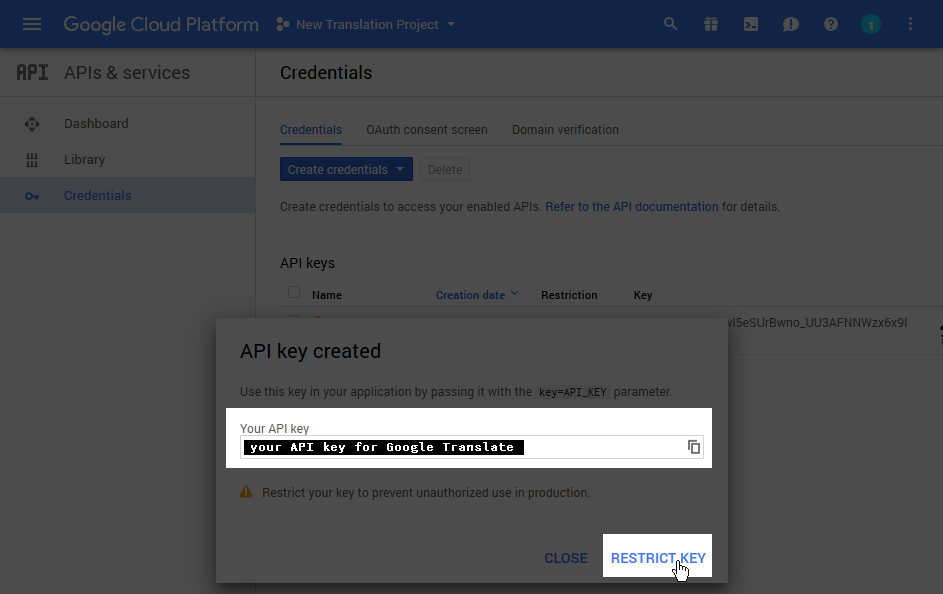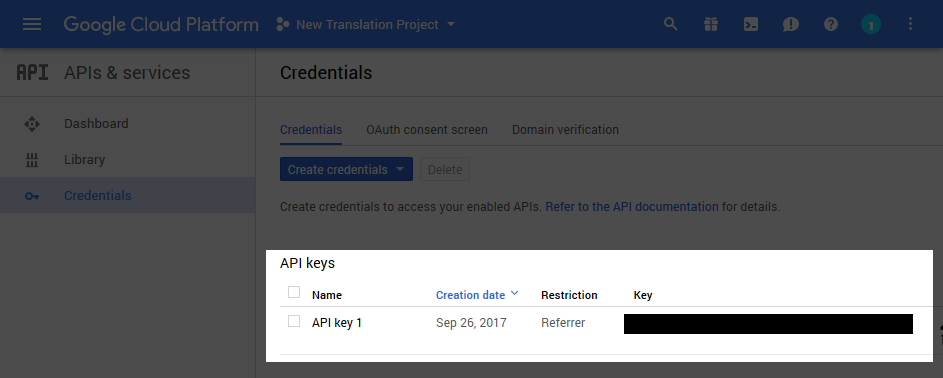Generate Google Translate Api Key
- Dec 23, 2018 This video explains the procedure for creating an API key to use Google Translate API. Watch the video until the end and follow the procedure carefully to create an API key.
- From Dashboard enable Google Translate API. Search for translate API and enable it. From the credentials interface create a new API Key. Restrict your API Key to a particular website. In Google Dashboard, use the HTTP Referrer provided in the description of the Google Translate API Key field in Settings - TranslatePress - Automatic Translation tab, as shown in the following screenshot.
I am attempting to hire a developer to program a Google Translate API call into salesforce. I need to provide him with an API key for Google Translate on our Google Cloud account but can't figure out how to generate that key. Here is a slightly outdated definition of the integration I want to ask him to build. Apr 10, 2020 composer install google/cloud-translate. For more on setting up your Python development environment, refer to the Python Development Environment Setup Guide. Pip install google-cloud-translate2.0.0. For more on setting up your Ruby development environment, refer to the Ruby Development Environment Setup Guide. Gem install google.
Setting up API keys for Google Translate
In order to create a Google Translate API Key you need a paid account. Through their terms and services, Google doesn’t allow for non-paid usage of their Translation API. If you don't reach the limit of requests (based on number of characters) they won't charge you anything ;)
For more information and to create your account (if you don't have it yet) please go to this site:
To create your application’s API key please go to the Cloud Platform Console.
1. Create a new Project from the top bar.
2. With the new project selected, go to the hamburger menu to the left and visit API & Services
From Dashboard enable Google Translate API
Search for translate API and enable it
3. From the credentials interface create a new API Key.
4. Copy your API Key for use in Translate.me
5. Add the API Key in Translate.me

Clone this wiki locally
Do not follow this guide if you are using OneSignal with a website or WordPress blog.
A Google Firebase Server Key is required for all Android mobile apps and Chrome apps & extensions. It is optional for Amazon apps.
What is a Firebase Server Key?
A Firebase Server Key and Firebase Sender ID are required in order to send push notifications to Android mobile app devices.
The goal of this section is to provision your Firebase Server Key and Firebase Sender ID for use in OneSignal.
Requirements
- An Android mobile app, Chrome app or extension, or an Amazon app. This is not for websites.
- A Google account
- A OneSignal Account, if you do not already have one.
Step 1: Create A Firebase Project
If you already have an FCM project you would like to use with OneSignal, you will need to retrieve your Sender ID and Firebase Cloud Messaging token. You may then skip to Step 2.
Visit the Firebase Console and sign in with your Google account.
Click CREATE NEW PROJECT or select an existing one below.
Openssl generate cert key pair. Enter a project name and press CREATE PROJECT.
Step 2: Getting Your Firebase Cloud Messaging Token And Sender ID
Click the gear icon in the top left and select Project settings.
Select the CLOUD MESSAGING tab.
Generate Google Translate Api Key Finder
Save the two values listed under Server key and Sender ID.
Google Translate Api Documentation
Step 3: Configure Your OneSignal App's Android Platform Settings
In the OneSignal dashboard, select your app from the All Apps page, then go to Settings. Under Native App Platforms, click Google Android.
Paste your Firebase Server Key and Firebase Sender ID into the fields and click Save.

Done! You now have a key to send push notifications from your app. 🥳
Next, install the OneSignal SDK in your app. If you need help, we have a few SDK-specific guides:
What's Next
| Android SDK Setup |
| Amazon SDK Setup |
| Chrome Extension SDK Setup |
| Mobile Push Quickstart |